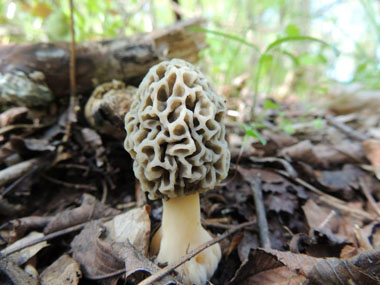










Do not eat any fungi that has not been properly identified by a qualified professional, some are DEADLY when ingested. All edible wild fungi MUST be cooked.
Morels belong to the Morchella genus because they are part of the "True Morels." The cap colour varies from pale cream, to ochre, to yellowish brown, sometimes slightly darkening with age. The ribs along the ridges between pits are usually slightly paler than the interior of the pits. Caps are tightly attached to the stem. Cut lengthwise it will be hollow from bottom of stem to top of cap; it looks like a rubber mold. The cap is longer than the stem. Most caps have a rounded cap with denser ridges yet some caps may have a more pointed cap appearance (still with the denser ridges).
Type
Distinguishing Features
Yellow morels are edible and have a distinctive honeycomb-like upper portion that is composed of a network of ridges and pits giving it a sponge-like appearance. The base is white or sandy-coloured, sometimes marked with brown blotches near the base; flesh is tough and it is hollow. IMPORTANT: There are false morels that are NOT edible - those caps are wrinkled not pitted and the cap hangs freely over the stem. There are recorded deaths from people eating false morels.
Height
Height can vary due to growing conditions and at what stage of growth they are at when you find them. Typically they grow to about 12cm (5").
Habitat
Morels can be found all over the Northern Hemisphere, especially in North America. They also grow in Asia and Europe and are found as far south as Central America. Morels are most commonly found in forested areas around dead elm trees, Sycamore, apple trees, under wood scraps and Ash trees, but can also be found in other areas especially in sandy woodlands. They tend to grow under objects on the such as decomposing leaves because of the dampness.
Spore Print
Creamy white or pale ochre.
Season
Mid-spring (usually mid-May). Black morels generally appear two weeks prior to the yellow morels. In warmer climates morels can appear as early as March and in colder climates grow until June.
Gills
n/a (pores).
Edibility
Always cook before consuming. They are usually enjoyed sauteed or added to favourite meals. In addition to being a sought-after food for us deer, elk and squirrels enjoy feasting on morels.
Other Name
Yellow Morel.
Recipes
To support our efforts please browse our store (books with medicinal info, etc.).
Winter Survival Food Handbook

PDF Plant Magazines
Types of Wild Food
Geographic Zones Seasons
Disclaimer
EdibleWildFood.com is informational in nature. While we strive to be 100% accurate, it is solely up to the reader to ensure proper plant identification. Some wild plants are poisonous or can have serious adverse health effects.
We are not health professionals, medical doctors, nor are we nutritionists. It is up to the reader to verify nutritional information and health benefits with qualified professionals for all edible plants listed in this web site. Please click here for more information.
Why Edible Wild Food?
- Food costs are rising
- Free, wild food is readily abundant
- Wild food adds nutrition to your diet
- Wild food can help treat various medical conditions





